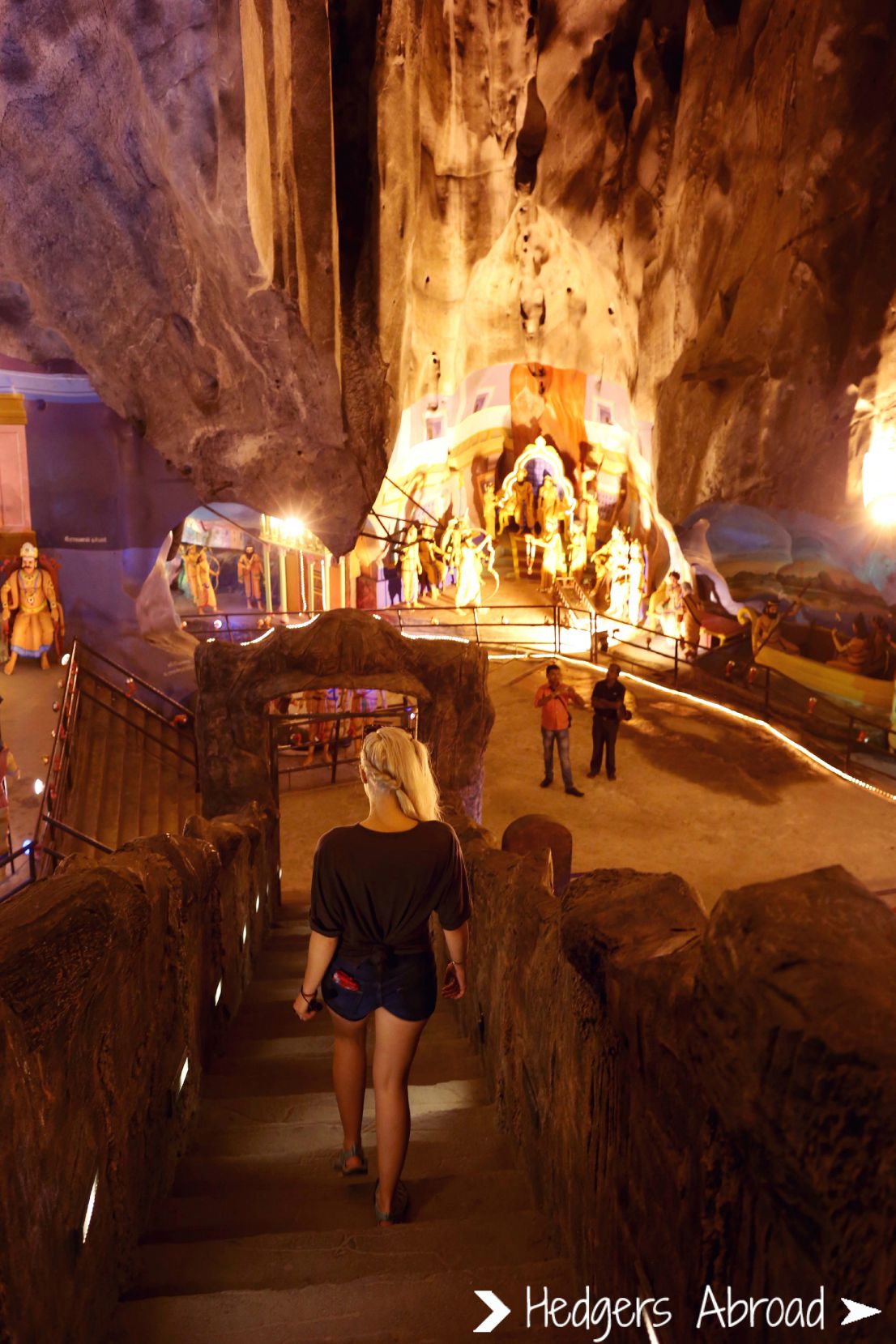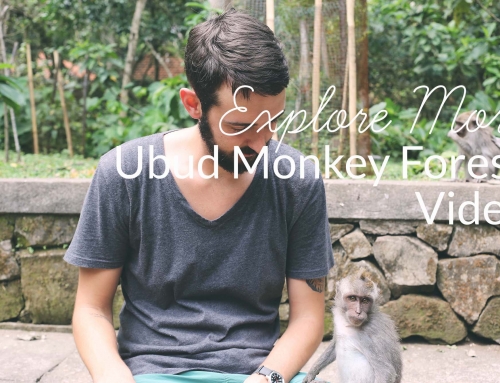When I first heard that there was a city in Southeast Asia where a giant golden statue stood as guard to a cave temple filled with monkeys, I was sold. It really doesn’t take a whole lot to get me excited about foreign places and every word of that description seemed to redefine what I wanted out of life itself. Caves? Awesome. Hindu temples? The Philosophy student within me is biting at the bit already. Giant golden statues? Show me this giant. Now you bring a herd/flock/pod/troop of macaques into the equation and I’m already trying to figure out how long I can keep the monkeys a secret so that Stephanie will travel willingly to this magical place. Stephanie hates monkeys.
- Cheers!
Put the Batu Caves in any city and I’d be interested to visit. As it happens, Kuala Lumpur was a city we’d never visited in a country that, so far, had not given our passports a stamp. Needing no further convincing, we added Malaysia’s capital city to our summer vacation as a layover stop for a chance to see how the Malaysians do “big city” and test my ability to keep the monkey secret from Stephanie. Being a city which we had never visited, we spent the first full day of our extended layover getting our bearings and visiting some markets. After gaining a foothold and learning their subway system, we set out for the Batu Caves on our last full day, excited to see some religious sites after touring the ultra modernity of Kuala Lumpur.
- “They’re gonna poop on me!”
- Cave stuff
- Oh yes!
- Lord Murugan
11 kilometers north of the city; we rode out of KL Sentral Station on the Kommuter train headed for the last stop. At Batu Cave Station we followed signs for the attraction through a parking lot and past some vendors selling souvenirs before we’d even been inside the caves until we were pooped out onto the sidewalk, free of the subway atmosphere and instantly immersed in the humidity of a cave complex with monkeys scattering for the nearest tourist holding bananas. We decided to include the smaller, optional cave in our plans and paid the small fee to enter.
- Interesting…
 Not technically part of the Batu Caves, the Ramayana Cave serves as an elaborate depiction of Hindu stories from ancient texts. Royal processions, battles between deities, and celebrations are displayed with elaborately painted and sculpted statues. This cave is fantastically large and has dozens of scenes that visitors can witness and gawk at for its intricate and ornate details. Each statue has a story and personality with deep ties with the traditions of Hinduism, especially the gods and beliefs of Malaysian Hinduism. The cave walls acted as borders to these large processions and depictions of Hindu tales until we eventually found a staircase cut into the stone near the back. As we climbed the slippery stones, our elevation and perspective on the whole scene changed. Higher up, we could see how truly beautiful the cave-turned-shrine can be. This protected sacred site provided natural protection to its content as well as a climate controlled and weather-indifferent location for worshiping peoples of the past.
Not technically part of the Batu Caves, the Ramayana Cave serves as an elaborate depiction of Hindu stories from ancient texts. Royal processions, battles between deities, and celebrations are displayed with elaborately painted and sculpted statues. This cave is fantastically large and has dozens of scenes that visitors can witness and gawk at for its intricate and ornate details. Each statue has a story and personality with deep ties with the traditions of Hinduism, especially the gods and beliefs of Malaysian Hinduism. The cave walls acted as borders to these large processions and depictions of Hindu tales until we eventually found a staircase cut into the stone near the back. As we climbed the slippery stones, our elevation and perspective on the whole scene changed. Higher up, we could see how truly beautiful the cave-turned-shrine can be. This protected sacred site provided natural protection to its content as well as a climate controlled and weather-indifferent location for worshiping peoples of the past.
- 10 Face Guy
Back outside we encountered our first monkeys at close proximity. Stephanie, now wise to my omissions when describing the caves, had set her mind to using my body as a shield as a troop of macaques playfully destroyed a bunch of bananas they’d stolen from a trashcan. We edged closer to take a few photos, but soon set off for the main caves and this statue of Murugan that I’d been longing to see. Standing at a whole bunch of feet tall, this is actually the largest statue of Murugan in the world. Highly respected by Malaysian and Singaporean Hindus, Lord Murugan stands head to toes covered in gold, proudly holding the body of the defeated serpent across his shoulders. At just 11 feet shorter than the Statue of Liberty in New York City, this massive golden statue is truly majestic in its size and beauty. Even with the large number of tourists present, the size of Murugan before us shifted our gaze upwards away from the other people which was unexpected and a well-conceived design aspect, for sure.
- 272 monkey filled stairs
- More cave stuff
- Tons of pooping birds!
After some relief from the day’s heat that tasted suspiciously like Diet Coke, we left our cafe to trudge up the 272 steps leading into the cave itself. As we passed beneath the golden statue to being our trek, we realized that the steps were a tourist destination all their own. With the flocks of monkeys lining the railings, dozens upon dozens of families, couples, and friends were stopped and feeding the monkeys sitting atop the walls and rails. While there was no small number of steps to begin with, most people presumably take a much longer time climbing than necessary, but Stephanie was less impressed by the terrifying, no good, dangerous monkeys so we took a few pictures and went on up.
- Almost… there…
- Inside cave stuff
- This is a monkey
- Inside cave stuff again!
Once we arrived at the top of the staircase, there was an adorned gate and a massive cavern beyond. The cave is mostly empty save for a few small shrines and trashcans used for maintaining the whole property. A few monkeys crossed our paths while in the cave but we soon passed to the far end where we soon began climbing a different set of stairs to the final temple and shrine. The cave ceiling gave way to a column of air as the cave dug skyward and revealed a blue sky above once we had reached the temple. Thankful to escape the stale air of the cave, we enjoyed this fresh air while we watched tourists entice monkeys with water bottles and food before immediately regretting their taunts when the monkeys became frustrated. After years of learning what actions get which reactions, the monkeys become the alpha species in places like the Batu Caves. A simple tug on a woman’s sarong, then the easy flash of teeth is an easy way to earn a new trophy to take high into the cave and stash on the rocks above. The attacks seemed scary at first, but it soon became clear how smart these macaques were, knowing just how hard to beat their chests to get what they wanted. They’ve got the tourists trained.
- Different angle of inside cave stuff
- Cave temple!
Heading back down those 272 steps, we were soon leaving the Batu Caves. Looking over Murugan’s shoulder you can see just how close the Batu caves are to Kuala Lumpur’s northern suburbs, and that gave a stunning dose of understanding in perception. Facing the statue and the rock face, we had forgotten about the city and imagined ourselves at this ancient and wonderful hidden treasure that few other had found before, but when leaving we were very much reminded that the statue was completed in 2007 and a stone’s throw from a taxi lineup. Don’t get me wrong, we loved the Batu Caves and will certainly return the next time we are in KL. Being so close to the city does have the advantage of making this cave temple complex accessible in a short amount of time for a large number of people and is definitely worth checking out if you are just passing through Kuala Lumpur and have a layover or if you’re exploring the city in depth. For its unique and interesting defining features, the Batu Caves are really amazing to visit and explore for a morning or afternoon if you’ve got the energy and strength to summit that staircase. If you are careful not to taunt the monkeys, you’re sure to enjoy the caves, statues, temples, and shrines as much as we did.























[…] For more pictures, check out our In Focus post HERE! […]